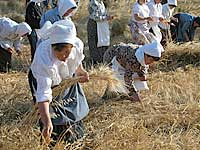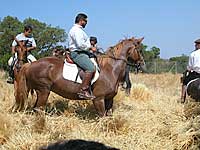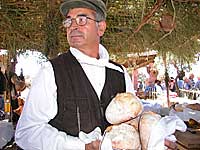
![]()
![]()
![]()
![]()
LIFE IN THE COUNTRYSIDE
THE HARVEST
PIAZZA FRONTERA
In this description of farming life we see the different phases of one of
the most important dates in the Sardinian agricultural world of yesteryear
and today.
 Towards
the 15th June the village square was overflowing with men armed with a simple
sack or backpack and that indispensable tool of their work: the scythe. Its
sharp, curved blade which was slightly tooth edged was wrapped in a cloth
so that their hands did not get caught on it by mistake, which would have
been trouble.
Towards
the 15th June the village square was overflowing with men armed with a simple
sack or backpack and that indispensable tool of their work: the scythe. Its
sharp, curved blade which was slightly tooth edged was wrapped in a cloth
so that their hands did not get caught on it by mistake, which would have
been trouble.
The scene seemed to be one of a slave market. They came from Marmilla and
Trexenta and were good harvesters, ‘is messadoris’.
Some came on bicycles, most on foot or even on a small train. They spent
the night in the village, waiting for a landowner to employ them. They slept
in the open in front of the Giunti house, in the small square in front of
the public market, or in ‘sa lolla de Nostra Signora’, the lodgings
of the Rosario Oratory. Late evening the landowners went to the square and
took on the harvesters they needed.
There were some who only needed one man; these were almost certainly heads
of the family who had sown their plot with wheat with their own needs, as
was the tradition. The harvester’s pay was not much, but together with
a few hundred liras some were given food: bread, water, boiled potatoes and
onions which were dressed in oil, salt and vinegar. Some, but not all were
also given wine.
They went from one owner to another until the end of the season when they
then returned to their villages to harvest their grain which usually ripened
later.
THE HARVEST (A MESSAI)
 The
scythe was very sharp and ‘s’azraxadura’, the hardening
was done by the blacksmith. The harvesters worked all day and sometimes when
there was a full moon also all night, stopping only for the shortest time
necessary to rest. At first light the ‘is messadoris’, the harvesters
lined up in front of ‘sa tenta’ the field to be harvested.
The
scythe was very sharp and ‘s’azraxadura’, the hardening
was done by the blacksmith. The harvesters worked all day and sometimes when
there was a full moon also all night, stopping only for the shortest time
necessary to rest. At first light the ‘is messadoris’, the harvesters
lined up in front of ‘sa tenta’ the field to be harvested.
In their right hand they held the scythe and with their left
they held ‘su mannugu’, the sheaf of harvested wheat that they
tied together by wrapping another piece of wheat around it and then they laid
one sheaf on top of another on the ground. When they had seven sheaves ‘mannugus’,
they tied them together with stalks of the same heads and they made ‘sa
maiga’, a stook, that was placed on its feet with the heads facing up.
To protect themselves they wore sturdy clothes, mitts covering their forearms,
‘is manixibis’, and an apron ‘sa pann’ i ananti’.
 Along
with an overcoat they wore a neckerchief ‘su mucadori’ that was
placed between the back of the neck and hat and wrapped around the neck to
protect them from the burning sun and insects. They quenched their thirst
with water provided by the landowner, which was kept in ‘su frascu’,
a type of terracotta jug with a flat side or in a ‘cun sa carrededdu’,
a small bottle that was covered in straw to keep the water a bit cool. ‘Is
messadoris messant a scarada’, they usually harvested at piece rate.
Along
with an overcoat they wore a neckerchief ‘su mucadori’ that was
placed between the back of the neck and hat and wrapped around the neck to
protect them from the burning sun and insects. They quenched their thirst
with water provided by the landowner, which was kept in ‘su frascu’,
a type of terracotta jug with a flat side or in a ‘cun sa carrededdu’,
a small bottle that was covered in straw to keep the water a bit cool. ‘Is
messadoris messant a scarada’, they usually harvested at piece rate.
The piece rate workers competed among themselves to see who was best; the winner’s reputation spread among the owners.
The best workers showed off their talents by cutting the wheat
around their slower colleagues ‘dd’ accorrant’ and this
was considered a challenge that the younger ones, when they improved, would
try to emulate.
The owner often harvested together with the harvesters to set them an example
in speed and skill.
 Behind the cutters were serfs ‘is ispigadrixis’.
Behind the cutters were serfs ‘is ispigadrixis’.
There was almost always one for every cutter and they had to be authorised.
They collected the heads of wheat that always fell onto the ground. They divided
what they collected with the crop owner and in this way got what the family
needed in the way of wheat or if there was a single girl were able to get
her a dowry.
The women helped the owner load by lifting the stooks with two pronged, long
handled forks and passing them to people standing on the cart.
They then intertwined the forks so that the movement of the cart did not make
them fall.
The oxen or horse drawn cart had ‘sa carruba’ a sort of second
floor, made from a sheet of sticks that was about two metres high which helped
to increase the cart’s capacity.
THE CROP
 At
the end the wheat was put in sacks and taken to the grain store. The sacks,
which weighed about 100 grams were loaded onto the cart by two men and then
stored in ‘su sobariu’, a room with a heightened floor made of
wood.
At
the end the wheat was put in sacks and taken to the grain store. The sacks,
which weighed about 100 grams were loaded onto the cart by two men and then
stored in ‘su sobariu’, a room with a heightened floor made of
wood.
Some owners had silos, ‘sa loscia’ a cylindrical body made of
‘canna sperrada’, strips of bamboo weaved together.
At about 20 cm from the ground there was an opening of about 20 by 20 which was closed by a sliding door in wood or metal which was used to let out the grain when it was to be sold or used.
THRESHING (SA TREBADURA)
 The
horses were tied side-by-side with ‘su frenu cun is occhaialis’
a halter with blinkers.
The
horses were tied side-by-side with ‘su frenu cun is occhaialis’
a halter with blinkers.
A rope went from one bit to another and a man who acted as the fulcrum at
the centre of the threshing floor and urged the animals on held the head.
They started at a walk due to the difficulty that they had because their legs
were covered with sheaves to above their knees.
At the head of the horses there were always two that were well broken in, whilst in the middle they put the unbroken horses, which were slowly trained by following the other horses lead.
 After
a certain number of turns they changed direction.
After
a certain number of turns they changed direction.
They did this so that the horse at the centre did not become dizzy and to
trample the heads of wheat better, which were slowly, being opened and the
singular grains were deposited on the bed of the threshing floor.
The men who weren’t working the horses, circled around the outside throwing
back under the horses hooves what wheat had flown out.
 They
worked during the hottest hours of the day so that the straw and heads of
wheat were very dry and would break easily.
They
worked during the hottest hours of the day so that the straw and heads of
wheat were very dry and would break easily.
To complete the job the ‘furriai s’aroxoba’ were needed;
the men who with their fork, ‘su travutzu’, turned over the straw
and wheat which was almost totally broken down. For the threshing they often
used instead of local horses the Giara ponies and oxen.
These were tied up to a block of granite ‘sa pedra de
trebai’ with a chain that started at ‘su giuabi’, the yoke.
This, when pulled over the wheat quickly crushed it. The animals that worked
in ‘s’arxoba’ usually had ‘sa sporta’, a concave
shaped metal net, attached to the bit, so that they could not eat the hot
straw, which would have wasted time and at the same time caused digestion
problems.
THE FARMYARD (SA BENTUADURA)
 Having
loaded the cart, ‘sa carruba’, the landowner or his servant went
to take their precious cargo to the farmyard, ‘s’arxoba’.
Having
loaded the cart, ‘sa carruba’, the landowner or his servant went
to take their precious cargo to the farmyard, ‘s’arxoba’.
Often the threshing floor had been specially built on the owner’s land ‘su padru’ by the owner himself. Not everyone had one and often the smaller landowners asked to borrow it. Here the sheaves were arranged forming ‘su patroxu’ a stack ready for threshing.
‘S’arxoba’ the threshing floor was in the form of a circle of about 10 metres or more in diameter with a heavy underlay and a layer of earth which had been beaten down so that it was resistant to the hooves of the animals, either horses or oxen that ran or walked on it to ‘trebai’ trample the sheaves.
 The
threshing floor was never ploughed and stayed intact over time ready for the
next harvest. When harvesting season was imminent, the threshing floor was
cleaned and swept with ‘is scovas de linna’, an arched branch
of ‘fillirea’ or olive and then they filled the holes that had
been made by ants or other animals.
The
threshing floor was never ploughed and stayed intact over time ready for the
next harvest. When harvesting season was imminent, the threshing floor was
cleaned and swept with ‘is scovas de linna’, an arched branch
of ‘fillirea’ or olive and then they filled the holes that had
been made by ants or other animals.
The sheaves were placed together leaving from the centre towards the exterior in circles with the cut part on the ground and the heads facing up.
 Only
a small space was left to walk around.
Only
a small space was left to walk around.
When the circle was completely full they started ‘a trebai’ threshing.
Having unloaded ‘sa carruba’ the cart returned to the fields where another load was waiting.
Si ringrazia Federico Barbarossa
per la traduzione
Pubblicato in Concierge, Sardegna information, anno 1 n. 2 agosto –
novembre 2